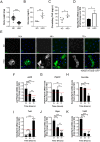Domeless receptor loss in fat body tissue reverts insulin resistance induced by a high-sugar diet in Drosophila melanogaster
- PMID: 33547367
- PMCID: PMC7864986
- DOI: 10.1038/s41598-021-82944-4
Domeless receptor loss in fat body tissue reverts insulin resistance induced by a high-sugar diet in Drosophila melanogaster
Abstract
Insulin resistance is a hallmark of type 2 diabetes resulting from the confluence of several factors, including genetic susceptibility, inflammation, and diet. Under this pathophysiological condition, the dysfunction of the adipose tissue triggered by the excess caloric supply promotes the loss of sensitivity to insulin at the local and peripheral level, a process in which different signaling pathways are involved that are part of the metabolic response to the diet. Besides, the dysregulation of insulin signaling is strongly associated with inflammatory processes in which the JAK/STAT pathway plays a central role. To better understand the role of JAK/STAT signaling in the development of insulin resistance, we used a simple organism, Drosophila melanogaster, as a type 2 diabetes model generated by the consumption of a high-sugar diet. In this model, we studied the effects of inhibiting the expression of the JAK/STAT pathway receptor Domeless, in fat body, on adipose metabolism and glycemic control. Our results show that the Domeless receptor loss in fat body cells reverses both hyperglycemia and the increase in the expression of the insulin resistance marker Nlaz, observed in larvae fed a high sugar diet. This effect is consistent with a significant reduction in Dilp2 mRNA expression and an increase in body weight compared to wild-type flies fed high sugar diets. Additionally, the loss of Domeless reduced the accumulation of triglycerides in the fat body cells of larvae fed HSD and also significantly increased the lifespan of adult flies. Taken together, our results show that the loss of Domeless in the fat body reverses at least in part the dysmetabolism induced by a high sugar diet in a Drosophila type 2 diabetes model.
Conflict of interest statement
The authors declare no competing interests.
Figures




Similar articles
-
Human type 2 diabetes mellitus-associated transcriptional disturbances in a high-sugar diet long-term exposed Drosophila melanogaster.Comp Biochem Physiol Part D Genomics Proteomics. 2021 Sep;39:100866. doi: 10.1016/j.cbd.2021.100866. Epub 2021 Jun 16. Comp Biochem Physiol Part D Genomics Proteomics. 2021. PMID: 34192612
-
Insulin stimulates translocation of human GLUT4 to the membrane in fat bodies of transgenic Drosophila melanogaster.PLoS One. 2013 Nov 6;8(11):e77953. doi: 10.1371/journal.pone.0077953. eCollection 2013. PLoS One. 2013. PMID: 24223128 Free PMC article.
-
The water extract of Potentilla discolor Bunge (PDW) ameliorates high-sugar diet-induced type II diabetes model in Drosophila melanogaster via JAK/STAT signaling.J Ethnopharmacol. 2023 Nov 15;316:116760. doi: 10.1016/j.jep.2023.116760. Epub 2023 Jun 8. J Ethnopharmacol. 2023. PMID: 37301307
-
Novel studies on Drosophila melanogaster model reveal the roles of JNK-Jak/STAT axis and intestinal microbiota in insulin resistance.J Drug Target. 2023 Mar;31(3):261-268. doi: 10.1080/1061186X.2022.2144869. Epub 2022 Nov 10. J Drug Target. 2023. PMID: 36343203 Review.
-
Phenotyping of Drosophila Melanogaster-A Nutritional Perspective.Biomolecules. 2022 Jan 27;12(2):221. doi: 10.3390/biom12020221. Biomolecules. 2022. PMID: 35204721 Free PMC article. Review.
Cited by
-
A low-sugar diet enhances Drosophila body size in males and females via sex-specific mechanisms.Development. 2022 Mar 15;149(6):dev200491. doi: 10.1242/dev.200491. Epub 2022 Mar 28. Development. 2022. PMID: 35195254 Free PMC article.
-
The Genetics of Diabetes: What We Can Learn from Drosophila.Int J Mol Sci. 2021 Oct 19;22(20):11295. doi: 10.3390/ijms222011295. Int J Mol Sci. 2021. PMID: 34681954 Free PMC article. Review.
-
Insulin-Like Peptides and Cross-Talk With Other Factors in the Regulation of Insect Metabolism.Front Physiol. 2021 Jun 29;12:701203. doi: 10.3389/fphys.2021.701203. eCollection 2021. Front Physiol. 2021. PMID: 34267679 Free PMC article. Review.
-
The Intestinal Immune Defense System in Insects.Int J Mol Sci. 2022 Dec 1;23(23):15132. doi: 10.3390/ijms232315132. Int J Mol Sci. 2022. PMID: 36499457 Free PMC article. Review.
-
Endocrine Regulation of Lifespan in Insect Diapause.Front Physiol. 2022 Feb 15;13:825057. doi: 10.3389/fphys.2022.825057. eCollection 2022. Front Physiol. 2022. PMID: 35242054 Free PMC article. Review.
References
-
- World Health Organization . Global Report on Diabetes. Geneva: WHO; 2016.
-
- Weiss, M., Steiner, D. F., & Philipson, L. H. Insulin Biosynthesis, Secretion, Structure, and Structure-Activity Relationships (2000). - PubMed
Publication types
MeSH terms
Substances
LinkOut - more resources
Full Text Sources
Other Literature Sources
Molecular Biology Databases

